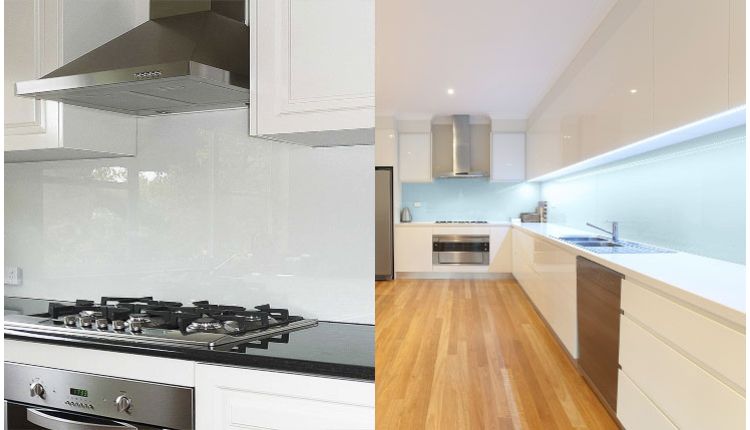When it comes to kitchen design, the choice of materials for your splashback can significantly influence the space’s aesthetic and functional aspects. Among the myriad options available, kitchen splashbacks stand out as a versatile and stylish choice. In this comparative analysis, we’ll pit glass against other popular materials like tiles and stainless steel.
- Glass Splashbacks: The Elegant All-Rounder
Pros:
Sleek Aesthetics: Glass splashbacks exude modernity and elegance, making them popular for contemporary kitchens. Their seamless surface contributes to a clean and streamlined look.
Reflective Properties: Glass can reflect light, creating a brighter and more open feel in the kitchen. This is especially advantageous in smaller spaces or areas with limited natural light.
Easy to Clean: The smooth surface of glass is easy to clean and maintain. Spills and splatters can be wiped away effortlessly, making it a practical option for busy kitchens.
Versatile Customisation: Glass splashbacks offer a wide range of customisation options. From choosing different colours to incorporating printed designs, homeowners can tailor the glass to match their style and preferences.
Cons:
Cost: Glass splashbacks, especially those with custom designs, can be more expensive upfront than other materials. However, many homeowners consider the investment worthwhile for its aesthetics and durability.
Installation Complexity: Installing glass splashbacks may require professional expertise to ensure a seamless fit. DIY installation can be challenging due to the precision needed to achieve a flawless result.
- Tile Splashbacks: The Timeless Classic
Pros:
Endless Design Options: Tiles come in many colours, patterns, and sizes, providing limitless design possibilities. This makes them suitable for various kitchen styles, from traditional to modern.
DIY-Friendly: Tile installation is often considered more DIY-friendly than other materials. Homeowners with basic tiling skills may take on the installation themselves, potentially reducing overall costs.
Cons:
Grout Maintenance: The grout between tiles requires regular cleaning and maintenance to prevent discolouration and mildew growth. This can be a drawback for those seeking a low-maintenance option.
Susceptible to Cracks: While durable, tiles are susceptible to cracking, especially in high-traffic areas. Individual tiles may need replacement if damage occurs.
- Stainless Steel Splashbacks: The Industrial Chic
Pros:
Sleek and Modern: Stainless steel adds an industrial and contemporary flair to the kitchen. It’s a popular choice for those looking professional and elegant.
Durable and Heat-Resistant: Stainless steel is heat-resistant, making it an ideal choice for areas near stovetops. It is also durable and can withstand impacts better than some other materials.
Cons:
Scratch Prone: Despite its durability, stainless steel is prone to scratching. This means that it may develop a patina of scratches and scuff marks over time, especially in a busy kitchen.
Cost: Stainless steel is generally more expensive than tiles but may be comparable or slightly more affordable than custom glass splashbacks.
Making the Right Choice: Factors to Consider
- Budget:
Consider your budget constraints when choosing a splashback material. While glass and stainless steel tend to be on the higher end, tiles and acrylic offer more budget-friendly options.
-
Aesthetic Preferences:
Evaluate the overall aesthetic you want to achieve in your kitchen. Glass provides a sleek and contemporary look, tiles offer endless design possibilities, stainless steel adds an industrial touch, and acrylic provides affordability with customisation.
-
Maintenance Requirements:
Consider your tolerance for maintenance. Glass and stainless steel are relatively easy to clean, while tiles may require more attention to grout maintenance.
-
DIY vs. Professional Installation:
Assess your comfort with DIY projects. If you’re keen on a DIY installation, tiles and acrylic may be more suitable. Glass and stainless-steel installations often benefit from professional expertise.
-
Durability:
Factor in the durability requirements for your kitchen. If you prioritise a material resistant to scratches and heat, stainless steel or glass may be preferable.
Conclusion: Tailoring Your Kitchen to Perfection
Choosing the proper kitchen splashback involves carefully considering your priorities, preferences, and practical needs. Each material has advantages and drawbacks, allowing you to tailor your choice to match the unique character of your kitchen and lifestyle.
Opt for glass if you desire a seamless, reflective surface that brightens the space. Choose tiles for their timeless appeal and endless design options. Select stainless steel for an industrial and durable aesthetic.
Ultimately, the perfect splashback material is the one that aligns with your vision for the kitchen and meets the demands of your daily life. By weighing the pros and cons of each material, you’ll be well-equipped to make an informed decision and create a kitchen that functions efficiently and reflects your style.
